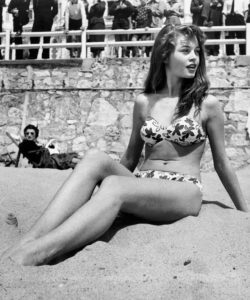
Boomer ladies, I’m sure that if I cross the chauvinistic line in today’s piece, you’ll be more than happy to let me know.
What would a beach party movie be without Annette Funicello in her bikini? Fortunately, the world of the 60’s didn’t have to find out. That’s because the two-piece bathing suit, once considered so risqué that ladies who sported one risked arrest, was a commonplace sight on American beaches of the 1960’s, much to the delight of all of us who possess a Y chromosome.
The bikini’s history is a venerable one. 4th century CE artwork discovered in Sicily depicts Roman ladies exercising while wearing what today would be considered bikinis.
But the Dark Ages, the Victorian Era, and predominant social mores kept the two-piece outfit that was intended to be worn in public by members of the fairer sex pretty much out of circulation until 1946. It was in that year that Frenchmen Jacques Heim and Louis Reard designed and released what was called for the first time the bikini. The diminutive swimsuit was named after Bikini Atoll in the Pacific, the site of the much hailed (at the time) atomic bomb tests which began taking place that same year.
However, bikinis were still rarely spotted on US beaches for several years afterwards. It was Brigitte Bardot’s performance in Roger Vadim’s scandalous And God Created Woman in 1956 (but not released in the US until the next year) that opened the floodgates.

To the horror of the generation that raised our Depression-era parents, bikinis began appearing en force on beaches from Daytona to Oahu, and everywhere in between. Girls loved the freedom experienced from wearing a suit that allowed so much skin to see the sun and, well, I think you know why boys loved them.
Of course, it was only the most nubile of female bodies that were equipped with bikinis, but since the most nubile bodies were the ones photographed to appear on TV, in movies, and on the pages of magazines, it did indeed appear that the world had been taken over by bikinis.
As if the craze didn’t have enough momentum, in 1960 Brian Hyland released Itsy Bitsy Teeny Weenie Yellow Polka Dot Bikini, considered scandalous in its own right. The song hit #1, despite the fact that some radio stations refused to play it.
In 1964, Sports Illustrated began a much-loved, much-reviled tradition by depicting on its March cover an image of a young lady wearing a bikini.

The aforementioned Ms. Funicello was also a driving force behind the popularity of the bikini, seeing how perfectly it fit her form in the wildly popular surf movies.
Thus, the beaches we recall from the 60’s had lots of bikinis, much to the horror of our puritanical grandparents. But it could have been worse. In 1964, Austrian designer Rudi Gernreich released the monokini, which allowed the breasts the ultimate in freedom. It was one of the very few things a little too wild for the 60’s, and died a quiet death.
The birth of the 70’s saw the bikini take yet another scandalous turn. Way down south in Rio, bikinis began appearing that exposed the buttocks. In other words, the thong was born. Popular on the more footloose Brazilian beaches, it took several years before they began appearing here in the US.
Such is the history of the bikini. And here’s to Boomer ladies like my wife, who have worked hard to stay in shape so that they still look stunning in the once-considered-risqué beachwear.